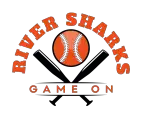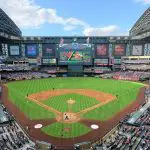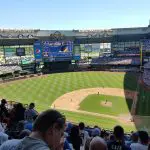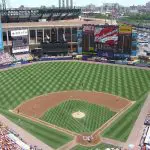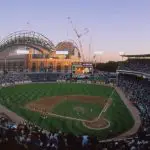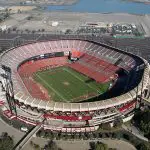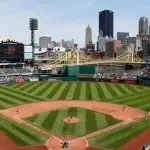Tenant: Brooklyn Dodgers
Capacity: 23,000 (original), 32,000 (final)
Surface: Grass
Cost: $750,000
Opened: April 9, 1913
Closed: September 24, 1957
Demolished: February 25, 1960
Dimensions: 419-L, 450-C, 301-R (original), 348-L, 393-C, 297-R (final)
Architect: Clarence Randall Buskin
Location: At 55 Sullivan Place, along Montgomery St., Franklin Ave., and Bedford Ave.
History Of Ebbets Field Stadium
Baseball in Brooklyn dates back as far as the 1850s, so there is plenty of history to delve into! Ebbets Field stadium is commonly thought of as the most nostalgic stadiums ever built, and it’s likely to be remembered forever more among baseball fans.
In 1884, the Brooklyn baseball club became a part of the American Association and they played all of their games in the original Washington Park.
In the early 1900s, Charles Ebbets purchased the Dodgers and made plans to build them a new steel and concrete stadium. This was to avoid the stadium being burned down, as this was the unfortunate fate of many ballparks at the time that were built from wood.
Ebbets chose a place in the slums of Brooklyn, where over 40 people owned parcels of the land. Ebbets made it his mission to purchase these in 1905, and by 1912 he had 1,200 parcels in total which was enough to start the construction of the Ebbets Field stadium.
Construction started on March 14, 1912, and only took 13 months to complete. Until 1931 there were three major additions to the stadium, but after this year there was very little changed until the stadium closed on September 24, 1957.
In the 1940s to 1950s, the stadium became structurally unsound. The plumbing was also bad and the capacity was small compared to other baseball stadiums at the time. There was also limited parking and it was difficult to get to by car.
In 1946, the new Dodgers owner Walter O’Malley commissioned a new stadium to be built with a new capacity of 52,000. The Dodgers moved to Los Angeles and the stadium remained untouched and unused.
After three years, in February 1960, the Ebbets Field stadium was finally demolished and replaced with a block of apartments.
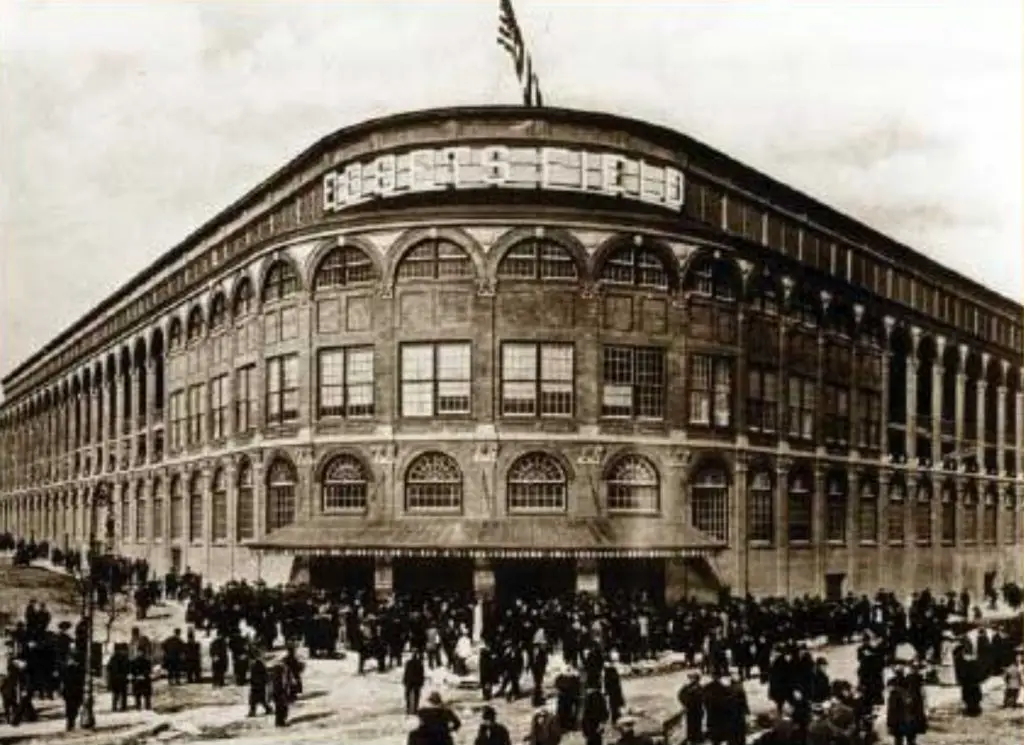
Who / What Is It Named After
The Ebbets Field stadium was named after Charles Ebbets, who purchased the Brooklyn Dodgers in the early 1900s. He took it upon himself to build an expensive new stadium for the team, purchasing land for it over a span of 7 years.
The stadium was named after Ebbets deservingly, and the name was never changed throughout the 44 years that it was active.
When Did It Open
The Ebbets Field stadium was opened on April 9, 1913, when the Dodgers played their first game there against Philadelphia. The game, unfortunately, ended in a loss for the Brooklyn Dodgers, but it was nice to finally have their own high-quality stadium to call home.
What Team Plays There
Ebbets Field Stadium was the home of the Brooklyn Dodgers for over four decades. Over the first three decades of its existence, the Dodgers team had a number of names such as the Atlantics, Grays, Bridegrooms, Grooms, Superbas, and Trolley Dodgers.
So, while you might hear a number of names of teams that used to play at Ebbet Field stadium, they are all referring to the Brooklyn Dodgers.
Location
Located in Brooklyn, you could have found the Ebbets Field Stadium at 55 Sullivan Place, along Montgomery Street, Franklin Avenue, and Bedford Avenue.
Now that the stadium has been demolished, the only thing you will find at this address is a block of apartments on the old stadium ground. However, there is still a plaque placed there to commemorate the existence of the ballpark.
Capacity (Seated & Standing)
When the stadium was first opened in 1913, the initial capacity was 23,000 people. This was made out of a double-decked grandstand wrapping around the home plate, from the left-field foul pole to the right-field foul pole.
The first addition to the Ebbets Field stadium was in 1926 and saw bleachers added to the outfield. In 1931 another addition was completed, with the double-decked grandstand extended all the way down to the third baseline and around the left-field foul pole into center field.
The upper deck in the left-field hung over the playing field and offered a great view of the action. By the final addition was completed the capacity was increased to 32,000.
What Are The Stadium Dimensions
The initial dimensions of the Ebbets Field stadium were as follows:
Leftfield: 419 feet
Centerfield: 450 feet
Rightfield: 301 feet
After the final addition; however, the dimensions were slightly altered at:
Leftfield: 348 feet
Centerfield: 393 feet
Rightfield: 297 feet
Seating Chart
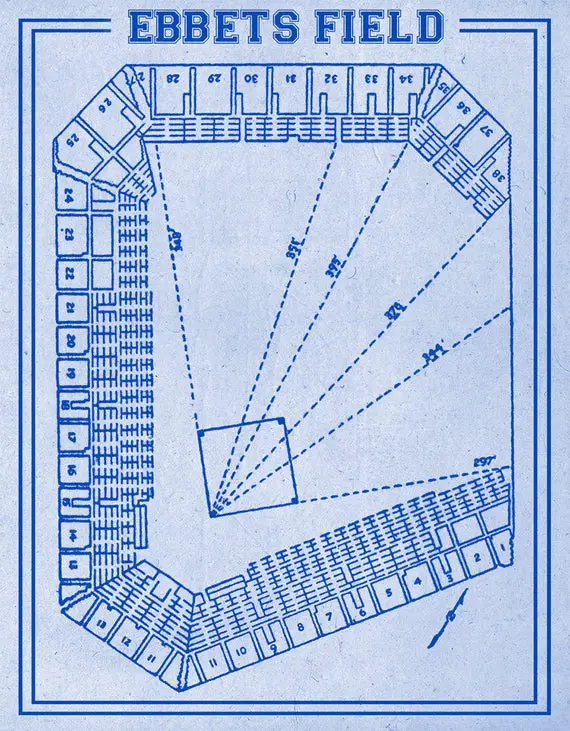
Seats For Sale
When the demolition began, seats were taken from the stadium and sold to fans for $5. Pieces of sod were also sold for 25 cents to fans so that they could all keep a piece of the stadium alive in their own homes.
There are now a select few seats being resold online for an incredible profit, although these are scarce and quite rare to find. One that we did manage to track down was an advertisement for three Ebbets Field stadium chairs, being sold for $15,000! That’s an incredible increase in cost over the last 60 years.
Best Seats
The best seats in the Ebbets Field stadium were positioned behind the home plate so that the fans could see most of the action. A lot of the seats were positioned on the ground, meaning that a lot of the fans had a view of what the players could see.
However, the further away you got from the home plate, the further away you would be from the action and the worse the seats would be.
Seats on the upper level also offered impressive views, particularly the upper deck seating over the left field. This offered an excellent bird’s eye view of the game so that you could see everything that was happening throughout its duration.
Notable Features
One of the most notable features of the Ebbets Field stadium was the exterior, which featured numerous arches and impressive brickwork. The entrance to the home plate was its most impressive feature, with an 80-foot rotunda made from Italian marble.
The people among the Ebbets Field stadium were some of the most notable features of the stadium, with Gladys Gooding playing the organ that could be heard throughout the entire stadium. This was baseball’s first full-time organist and started a strong tradition that is still alive today.
Another person who made the Ebbets Field stadium what it was in its prime was Hilda Chester, a fan who would sit in the bleachers of games and make lots of noise with a cowbell.
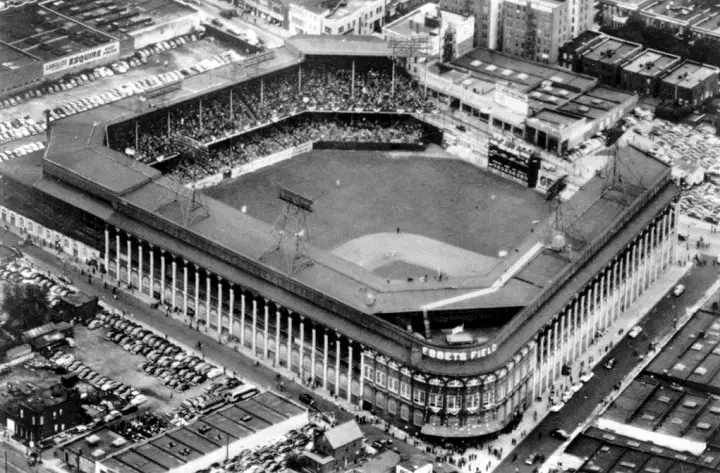
Memorabilia
There is a lot of memorabilia that you can find online of the Ebbets Field stadium, such as photos, programs of the old games, and old Dodgers flags. The majority of the memorabilia up for grabs is framed images of the stadium and memorable moments.
There are also a few 3D ballpark replicas of the stadium, and even a baseball with the stadium printed onto it.
Of course, you can always get your hands on some of the original seating from the stadium if you have a lot of money to spend!
Tickets
You can find a few Ebbets Field Stadium tickets online that are now being sold to vintage sports collectors. However, you can expect these to be expensive. Not as expensive as the chairs, but still quite pricey.
For reference, we found an auction website that still has its advertisement for 35 Brooklyn full Ebbets Field tickets, with a final price of $1,380. This is just shy of $40 per ticket. Bear in mind that this action was closed in 1994, so imagine how much the price would have inflated over the past 25 years!
Mascot
There was an unofficial mascot at Ebbets Field stadium, starting in the late 1930s when a sport’s cartoonist Willard Mullin developed a cartoon character called Brooklyn Bum, symbolizing the team’s losing streak.
Fans and reporters both started calling the Dodgers ‘Dem Bums’ because of this. Even Emmet Kelly, a circus clown who was responsible for characters such as the homeless character Weeping Willie for the Ringling Bros, started calling them ‘Dem Bums’.
Emmett Kelly would often get into the character of the Brooklyn Bum and appear at Ebbets Field stadium, becoming the unofficial mascot of both the stadium and the team. However, there was never an official mascot at this stadium, and we don’t think that the Brooklyn Dodgers would have been too happy with their Brooklyn Bum mascot.
Notable Events
There were a few notable events that were seen at the Ebbets Field stadium, such as the World Series in 1916, 1920, 1941, 1947, 1949, 1952, 1953, 1955, and 1956. An All-Star game was also played here in 1949.
Duke Snider saw 40 home runs at this stadium between 1953 and 1957, and Gil Hodges hit four home runs in one game on August 31, 1950.
